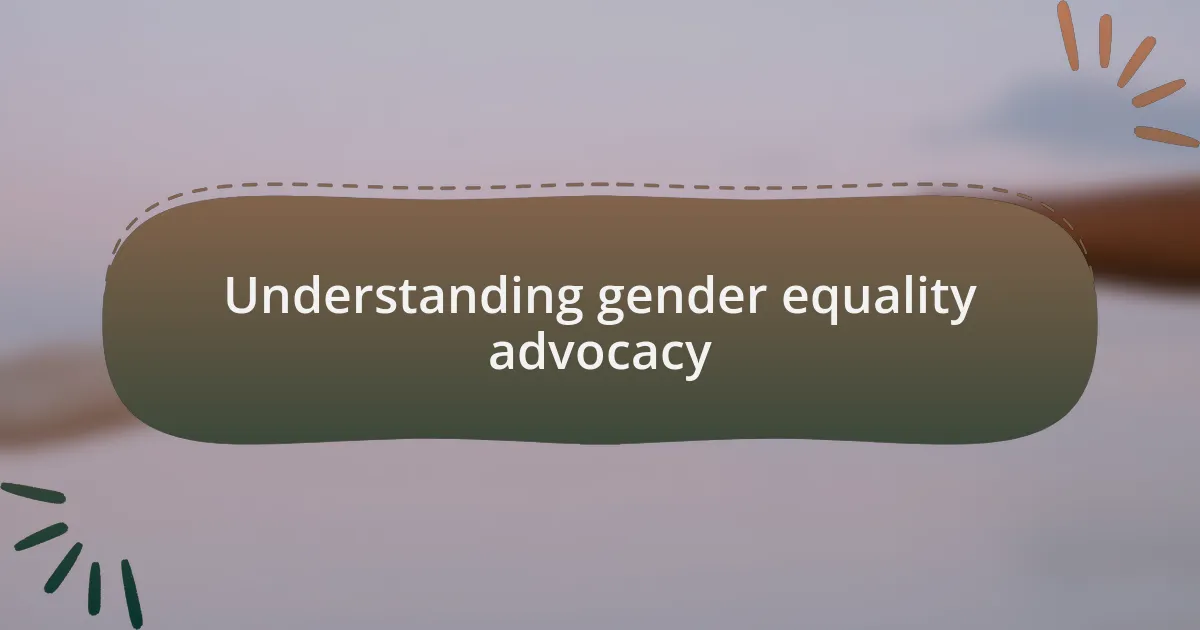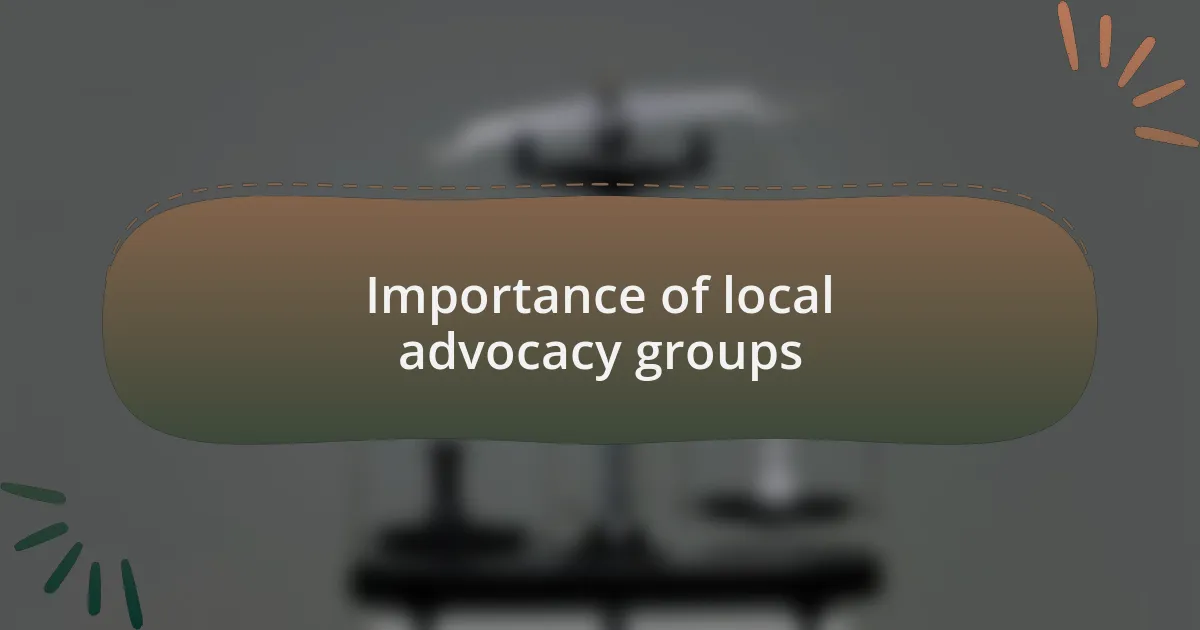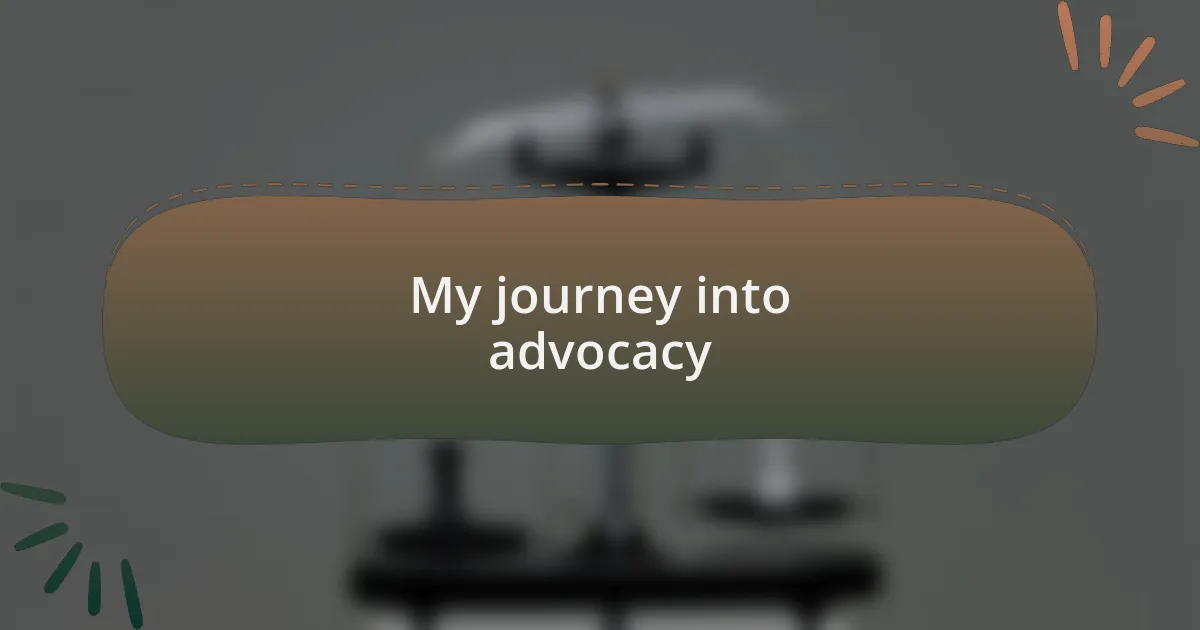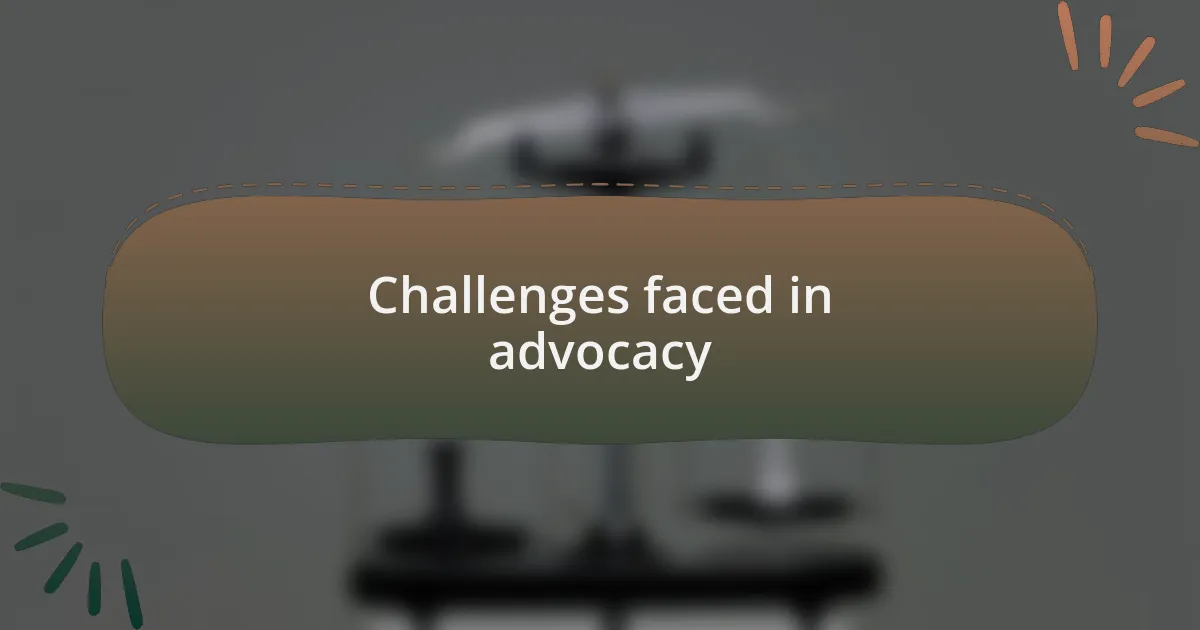Key takeaways:
- Gender equality advocacy is deeply personal and focuses on dismantling systemic barriers, highlighting the importance of shared experiences and grassroots movements.
- Local advocacy groups empower communities by breaking down complex issues into actionable steps and creating safe spaces for dialogue and connection.
- Effective strategies include storytelling, collaborative partnerships, and grassroots mobilization to amplify messages and engage broader audiences.
- Challenges in advocacy involve navigating bureaucratic hurdles, raising public awareness, and ensuring adequate resources for effective messaging and training.

Understanding gender equality advocacy
Gender equality advocacy is about striving for a world where everyone, regardless of gender, has equal rights and opportunities. I remember attending a local meeting where a passionate speaker shared her journey from struggling against societal norms to becoming a leader in her community. It was then that I realized how deeply personal this issue is—it’s not just about policies; it’s about people and their stories.
At its core, gender equality advocacy seeks to dismantle the systemic barriers that prevent individuals from thriving. Have you ever felt sidelined because of your gender? Those feelings highlight why advocacy is so crucial. I’ve seen firsthand the powerful impact of grassroots movements, where individuals band together, sharing their unique experiences to call for change.
Engaging with advocacy groups has taught me the importance of amplifying diverse voices. Each story brings richness to the movement, reminding us that gender equality isn’t just a political goal; it’s a shared human experience. How often do we stop to listen to those voices? In doing so, we enrich our understanding and strengthen our resolve to make lasting change.

Importance of local advocacy groups
Local advocacy groups play a pivotal role in fostering community involvement and awareness, especially when it comes to gender equality. I recall a time when I attended a local event organized by one such group. The energy in the room was palpable as people from different backgrounds came together to share their visions for a more equitable society. It struck me how these gatherings not only inform but also empower individuals to take action in their own neighborhoods.
What I’ve learned is that local advocacy groups serve as a vital link between individuals and larger movements. They break down complex issues into relatable, actionable steps. For example, I once joined a workshop where community members learned how to influence local policy. Seeing how this collective knowledge transformed our understanding was a game-changer for me. It made me question: how can we forget the power of grassroots efforts that are often the first to ignite change?
Moreover, these groups foster safe spaces for dialogue, allowing people to voice their experiences without fear of judgment. I’ve witnessed deep connections formed over shared challenges, where individuals found strength in vulnerability. Isn’t it incredible how discussing personal stories can lead to broader societal change? That’s the magic of local advocacy—it not only drives action but also nurtures a sense of belonging and purpose.

My journey into advocacy
My journey into advocacy began somewhat unexpectedly during a community gathering. I remember feeling a mix of excitement and nervousness as I approached a table filled with passionate advocates discussing gender rights. It was there that I met someone who shared their story of overcoming systemic barriers. Their words resonated with me deeply, igniting a fire within. I started to realize that my own story had the potential to foster change too.
As I delved deeper into the world of local advocacy, I found myself volunteering for a campaign focused on raising awareness about gender-based violence. The first time I spoke at a community forum, my heart raced. The supportive atmosphere made me feel safe to express my thoughts, and it was incredible to see so many others join in. I can still recall the moment when a young person approached me afterwards, sharing how my words inspired them to take action in their own life. That interaction taught me that advocacy isn’t just about raising awareness; it’s about amplifying voices that often go unheard.
Reflecting on my journey, I recognize how the experience has shaped me in profound ways. Engaging with others in this collective fight for equality has not only educated me but also fostered incredible bonds with people from diverse backgrounds. Have you ever felt that sense of unity when working towards a common goal? It’s transformative. Each dialogue and shared experience serves as a reminder of why advocacy is necessary and how, together, we can create a ripple effect of change in our communities.

Engaging with community organizations
Engaging with community organizations opened up a whole world of possibilities for me. I remember attending a local meeting for an advocacy group focused on women’s empowerment, feeling a mix of excitement and apprehension. When a fellow member shared how their grassroots efforts had directly impacted lives, I felt an urgent pull to contribute my own talents and resources to our shared vision.
One of the most rewarding experiences came when I collaborated with a local nonprofit on an awareness campaign. We organized a panel discussion featuring survivors of gender-based violence, and I was tasked with helping to facilitate. Witnessing their courage as they shared their stories was deeply moving; it reminded me that each engagement has the power to educate and inspire. Have you ever participated in an event that changed your perspective? That day certainly transformed mine, reinforcing the idea that listening is just as crucial as speaking.
I also learned that building relationships with these organizations requires vulnerability and authenticity. In one of my first outreach efforts, I hesitated to share my own experiences. However, when I finally opened up about my journey, I noticed the immediate shift in our conversations. It was as if my words created a bridge — not only did I connect with others, but I also realized that my story could serve as a beacon of hope for someone else. These connections are vital; they remind us that while the struggle may be challenging, we are not alone in this fight.

Strategies for effective advocacy
One effective advocacy strategy that I’ve personally observed is the importance of storytelling. I remember the impact of a colleague who shared her journey through systemic obstacles in accessing healthcare. Her authentic narrative not only resonated with our audience but also sparked conversations that had been dormant. Isn’t it fascinating how a simple story can unite people and provoke action?
Engaging in collaborative partnerships has also proven essential for driving change. I participated in a joint initiative between several advocacy groups that focused on educational outreach. By pooling our resources, we reached a far larger audience than any of us could alone. This experience made me realize that together, we can create a ripple effect, amplifying our messages and increasing our visibility.
Lastly, I’ve learned the significance of grassroots mobilization, especially in creating a sense of community around our cause. I once organized a community mural project that invited locals to express their views on gender equality through art. The excitement and creativity that blossomed during our sessions made it clear how much people yearned for a platform to voice their perspectives. Have you ever felt that surge of empowerment when your voice is heard? Creating spaces for dialogue not only raises awareness but fosters a collective sense of ownership in our mission.

Challenges faced in advocacy
Advocacy isn’t without its obstacles, and I’ve felt the weight of them firsthand. One challenge I encountered was navigating bureaucratic red tape. During a campaign to secure funding for a women’s shelter, I was disheartened to see how many hours were consumed by endless paperwork and approvals. It’s frustrating to think that a noble cause can get stalled by administrative complexities. Have you ever felt like your efforts were overshadowed by the system?
Another significant hurdle lies in public perception and awareness. There was a time when I organized a community discussion about gender equality, but turnout was disappointingly low. I realized that many people were either unaware of the issue or disconnected from its relevance. This made me question how we can effectively reach those who are on the sidelines. We need to find ways to break down these barriers and make the conversation more accessible.
Finally, resources can often be a limiting factor. I recall a campaign where we relied heavily on volunteers, and while their passion was admirable, the lack of training meant our messaging sometimes fell flat. This taught me that effective advocacy requires more than just dedication; it needs a strategic allocation of resources. How do we ensure that our advocates have the tools they need to succeed? It’s a question that seriously challenges our ability to make a lasting impact.